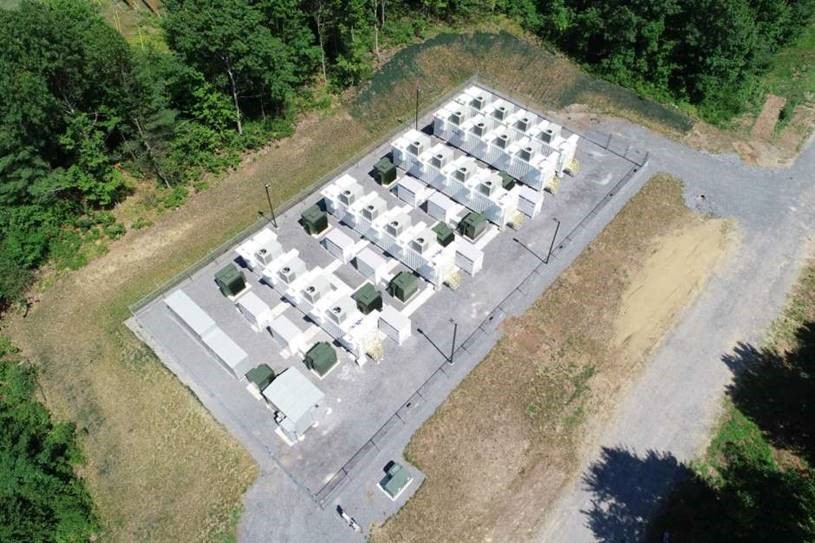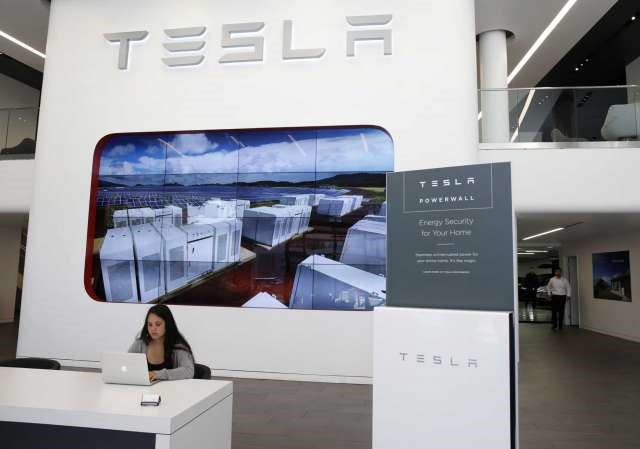Could utilities’ costly battery storage plans provide backup electricity — and savings?
The Connecticut Post
Key Capture Energy’s NY-1 battery facility in Saratoga County, N.Y., which can store 20 megawatts of electricity as needed for the grid. (Photo courtesy Key Capture Energy) Photo: Photo courtesy Key Capture Energy
By Alexander Soule Sep. 26, 2020 Updated: Sep. 26, 2020 6 a.m.
After its customers were left again rummaging through drawers for spare batteries during an extended power outage, the state’s utilities have filed plans to manage the mass roll-out of big batteries to feed electricity to homes or back onto the grid.
Eversource says it can see a net savings for Connecticut customers of nearly $200 million if it gets the gig.
Days before Tropical Storm Isaias wrecked the Connecticut grid leaving many customers in the dark for days, Eversource and Avangrid subsidiary United Illuminating filed formal proposals with state regulators to push battery storage technology out to residential and commercial customers. Eversource proposes to retain centralized control for batteries installed “behind the meter” on premises.
The Connecticut Public Utilities Regulatory Authority requested input last year as part of a larger modernization initiative for the Connecticut grid that would include “smart” meters.
Massachusetts and New York are already in the early stages of utility-scale battery builds, including a project by Eversource for a 25-megawatt system at the tip of Cape Cod.
“In terms of sites, it has to do more with the need in the area and how we can use batteries to address reliability needs,” stated Eversource spokesperson Caroline Pretyman in an email response to a query. “We are … considering ways to deploy energy storage across the state as an alternative to traditional investments in grid infrastructure and we have a proposal filed with PURA to provide incentives.”
The New York Power Authority is using batteries designed by Cadenza Innovation, which has offices in Wilton and Danbury and a test lab in Oxford. Cadenza CEO Christina Lampe-Onnerud co-chairs the World Economic Forum’s Global Future Council on Energy Technologies.

A Cadenza Innovation lithium ion rechargeable battery. Thursday, September 24, 2020, in Danbury, Conn. Photo: H John Voorhees III / Hearst Connecticut Media
“Everybody’s very eager to make this happen,” Lampe-Onnerud said. “We’re going to demonstrate a technology that can change energy transition for many generations to come.”
Cheaper power
Household batteries offer three big benefits, most notably storing electricity generated by solar panels during daylight hours to power lights and appliances at night; and taking over the role of backup generators during outages, though running the risk of draining in any prolonged blackout.
Larger, utility-scale batteries have benefits as well, including when light breezes or major storms limit the electric output of offshore wind farms, with Avangrid and Eversource both planning major installations off the southern New England coast.
And whether in the garage or at the substation, batteries also can provide an alternative source of cheaper power during peak periods, by socking electricity away before rates shoot up as power plants crank up turbines, or prices spike in winter for natural gas on which many plants depend for fuel.
“That kind of demand response coupled with scaled-up … battery technology — we need more of that, and yesterday,” said Katie Dykes, commissioner of the Connecticut Department of Energy and Environmental Protection. “We’ve got to get the market design and incentives right, to ensure that battery resources are valued and that we are sending the signals to investors that reflects the scale of deployment that we want and need here in New England.”
As of June, the Connecticut Municipal Electric Energy Cooperative was the state’s only utility with large storage battery installations in operation, according to a monthly report by the Energy Information Administration, including one for a solar farm feeding the U.S. Naval Submarine Base in Groton.
“Connecticut needs a storage market — period,” said PURA Chair Marissa Gillett, who arrived last year after working for the Energy Storage Association trade group which represents major battery manufacturers like Tesla. “The governor … tasked DEEP with coming up with pathways to get to 100 percent decarbonization by 2040, and from my perspective you can’t get to that goal without storage. You just can’t.”
Critical loads
Batteries do not come cheap, with Tesla the best-known manufacturer at present with its Powerwall batteries roughly the size of a large-scale TV. Eversource cites $13,000 as the average the cost of installing a household battery that can run at six kilowatts an hour in steady state, equating to six years of Connecticut electric bills on average. A 350 kilowatt battery system for a commercial establishment could run in the region of $1 million, according to Eversource.

A Powerwall backup battery for the home is displayed at the Tesla store in San Francisco, Calif. on Thursday, June 28, 2018. Photo: Paul Chinn / The Chronicle
Eversource anticipates a slow build-out, with plans to install 50 megawatts of battery capacity for a 15-year term. Connecticut’s electric load averages 3,700 megawatt hours, with spikes in summertime as air conditioners and dehumidifiers go into overdrive.
Under one set of assumptions, Eversource estimates it would cost $112 million to build out 50 megawatts of battery power. But it believes the systems would easily pay for themselves, producing $308 million in savings over 15 years. Savings would surface from using stored electricity that was generated and stored outside of peak periods, when costs were lower; reducing the impact of electric outages; and federal tax credits that could apply toward the purchase of batteries.
Five years ago, Avangrid hooked up New England’s first utility-scale battery system, to provide short-term boosts in power as needed to the company’s Central Maine Power subsidiary. Housed in a trio of structures about double the size of a cargo ship container, the batteries can provide half a megawatt of power — sufficient for the equivalent of more than 300 homes — for up to six hours before running out of juice.
“If you were to try and create a storage solution to fully cover normal residential operations over two weeks, you would need a fairly significantly sized battery, … we’re talking about probably like a 500-kilowatt [unit],” said Jason Burwen, vice president of policy for the Energy Storage Association, speaking in March to members of the Connecticut General Assembly’s Energy and Technology Committee. “The fact of the matter is, though, that for folks who are looking for residential backup they’re rarely going to go to that level of size even for an extended outage. … They may run critical loads but not all loads … to make sure certain things are running.”
‘Press a button’
ISO New England at last report was tracking proposals for more than 2,200 megawatts of battery storage capacity in the region in an “interconnection request queue” maintained by the regional grid overseer. If a big number, it is still far behind the 18,000 megawatts of wind and solar capacity in the pipeline. Despite the operating limitations of the COVID-19 pandemic, companies installed 186 megawatts of capacity in the second quarter, the second highest total on record.
“New energy storage technologies are emerging because of technology advances, falling costs, support from the states, and changes the ISO has made to better enable energy storage participation on the wholesale level,” stated ISO New England spokesperson Ellen Foley in an email. “The wholesale market structure is ready.”

Christina Lampe-Onnerud, CEO of Cadenza Innovation, in their offices at The Summit at Danbury, Thursday, September 24, 2020, in Danbury, Conn. Photo: H John Voorhees III / Hearst Connecticut Media
Lampe-Onnerud said those technical improvements include safety, with Cadenza receiving certification in August on a feature that shuts down its batteries at any sign of “thermal runaway” that can spark fires or explosions, which has made some consumers hesitant about purchasing electric vehicles.
PURA is now deliberating on what plans move forward, whether utilities’ or other market players’. The mix of battery sites is also in play — a Massachusetts study pegged the optimal mix of electricity storage at 40 percent in the form of batteries at utility substations that could feed electricity to local neighborhoods when needed.
Albany, N.Y.-based Key Capture Energy counts itself among the five largest operators of utility-scale energy storage sites nationally, with the firm now eyeing an expansion into Connecticut with sites in Bloomfield and Putnam. The Bloomfield battery storage plant would have 20 megawatts of capacity.
“Batteries are very complicated; they have to be modeled differently as they are both a generator and a load,” said Key Capture Energy CEO Jeff Bishop, in an interview. “There is a learning process for everyone — for the regulators, for the utilities, for the ISO — the first time you put a project like this online. That’s why we as a company have started small, doing 10 and 20 [megawatt] projects before we scale out to the 50 and 100-megawatt-size projects.”
Alex.Soule@scni.com; @casoulman